|
|
|
Sort Order |
|
|
|
Items / Page
|
|
|
|
|
|
|
| Srl | Item |
| 1 |
ID:
107373
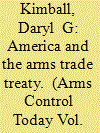

|
|
|
|
|
| Publication |
2011.
|
| Summary/Abstract |
Each year, thousands of civilians around the world are slaughtered by weapons sold to unscrupulous regimes and transferred to criminals and illegal militias. The enormous human toll of this cycle of violence undermines economic development and political stability in fragile regions.
|
|
|
|
|
|
|
|
|
|
|
|
|
|
|
|
| 2 |
ID:
119940
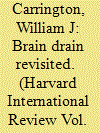

|
|
|
| 3 |
ID:
129431
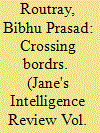

|
|
|
| 4 |
ID:
095562
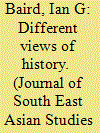

|
|
|
|
|
| Publication |
2010.
|
| Summary/Abstract |
The administrative boundary between Laos and Cambodia is amongst the least studied international borders in Southeast Asia. Since Laos and Cambodia became independent in 1953-54, relatively minor but sustained tensions have characterised border relations. An important reason for disagreements is irredentist feelings. Some ethnic Lao in both Laos and Cambodia believe that part of northeastern Cambodia should be added to Laos, while some ethnic Khmer in Cambodia insist that their border should be extended to include part of southern Laos. Different emphases and framings of history have contributed to irredentism and the development of identities in relation to the border.
|
|
|
|
|
|
|
|
|
|
|
|
|
|
|
|
| 5 |
ID:
159813
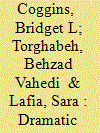

|
|
|
| 6 |
ID:
128142
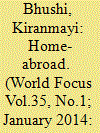

|
|
|
|
|
| Publication |
2014.
|
| Summary/Abstract |
There are various play of forces, institutions and actors that make up the transnational space, which effectively bring home and abroad together in newer ways than before. This paper purports to highlight these aspects of the transnational space. Transnational space and the related terms transnationlism is said to capture a condition in which despite great distances and notwithstanding the pretense to international borders, certain kinds of relationship are globally intensifying and have become denser between places and people.
|
|
|
|
|
|
|
|
|
|
|
|
|
|
|
|
| 7 |
ID:
139571


|
|
|
|
|
| Summary/Abstract |
This article focuses on two questions regarding the movement of persons across international borders: (1) do states have a right to unilaterally control their borders; and (2) if they do, are migration arrangements simply immune to moral considerations? Unlike open borders theorists, I answer the first question in the affirmative. However, I answer the second question in the negative. More specifically, I argue that states have a negative duty to exclude prospective immigrants whose departure could be expected to contribute to severe deprivation in their countries of origin. Countries have a right to unilaterally control their borders, but their exercise of this right is constrained by the demands of morality.
|
|
|
|
|
|
|
|
|
|
|
|
|
|
|
|
| 8 |
ID:
103890
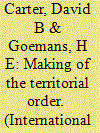

|
|
|
|
|
| Publication |
2011.
|
| Summary/Abstract |
We argue that new international borders are rarely new. We propose that when states choose new borders they use previous administrative frontiers to solve a difficult short-term bargaining problem and a long-term coordination problem. With a unique new set of data collected specifically for this project, we systematically examine the new international borders of the twentieth century resulting from secession, partition, and the use of force. New international borders, we find, are drawn not according to principles of "nationalism" or defensible borders, but rather according to previous administrative frontiers. How borders are drawn has important consequences for international stability: borders drawn along previously existing internal or external administrative frontiers experience fewer future territorial disputes and have a much lower risk of militarized confrontation if a dispute emerges.
|
|
|
|
|
|
|
|
|
|
|
|
|
|
|
|
| 9 |
ID:
133582
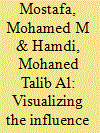

|
|
|
|
|
| Publication |
2014.
|
| Summary/Abstract |
The aim of this paper is to investigate why some internal conflicts are terminated quickly, while others linger for several decades without a looming resolution in the horizon. In an attempt to achieve this objective, the role played by geopolitical factors in the Arab world's internal conflicts was investigated. More specifically, we used Kohonen self-organizing maps, an artificial intelligence-based neural network technique, along with event duration models to investigate the role played by distance from the capital, access to international borders, terrain, valuable natural resources such as oil, and rebels fighting capability in civil wars in the Arab world. Using recently validated data spanning more than 50 years of Arab civil wars (1948-2003), our findings indicate that previously ignored geopolitical factors seem to play an important role in the duration of internal conflicts in the Arab World.
|
|
|
|
|
|
|
|
|
|
|
|
|
|
|
|
| 10 |
ID:
120933
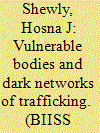

|
|
|
|
|
| Publication |
2013.
|
| Summary/Abstract |
Globally, trafficking is now a thriving and multi-billion dollar business run by organised criminal networks. An estimated 8, 00,000 women and children are trafficked each year across international borders, 80 percent ending in forced sex work. Although awareness is increasing, human trafficking still lack a global understanding of the subject, what United Nations Office on Drug and Crime identifies as 'a knowledge crisis about a crime that shames us all'. Bangladesh is predominantly an origin country for victims of trafficking while India is an origin, transit and destination country for this organised crime. In this context, Bangladesh-India border, the fifth longest land border of the world, is intensively used for women and girls trafficking in South Asia. The traffickers capitalise on complex political landscape of the border and borderland, poor border control mechanisms and lack of joint efforts to stop human trafficking. This paper contributes to the efforts to prevent human trafficking along this border. The main thrust of this article is to address the routes and networks of trafficking at the Bangladesh-India border, which is poorly addressed in academic writing. Here, this paper highlights on the aspects of human trafficking along this border and prioritises on joint initiatives by the border guards to reduce the magnitude of human trafficking significantly.
|
|
|
|
|
|
|
|
|
|
|
|
|
|
|
|
|
|
|
|
|